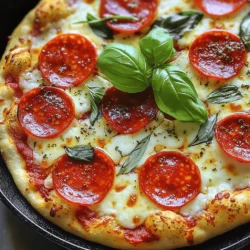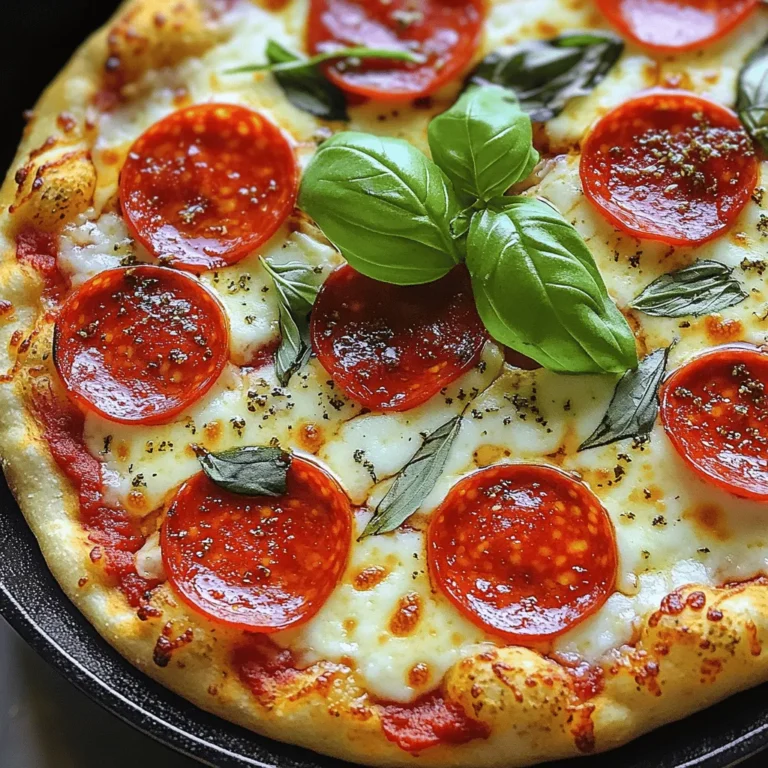Are you ready to make the best cast iron pizza ever? This recipe gives you that crispy crust you’ll love. Simple ingredients come together easily, and I’ll show you how to get the perfect slice. Whether you’re a pizza lover or just starting, this step-by-step guide will ensure your success. Let’s dive into the crispy, cheesy, and delicious world of cast iron pizza!
Ingredients
Dry Ingredients
– 2 cups all-purpose flour
– 1 teaspoon instant yeast
– 3/4 teaspoon salt
Wet Ingredients
– 1 tablespoon olive oil
– 3/4 cup warm water (about 110°F)
Toppings
– 1/2 cup pizza sauce (store-bought or homemade)
– 2 cups shredded mozzarella cheese
– 1/2 cup pepperoni slices (or your choice of toppings)
– 1 teaspoon dried oregano
– Fresh basil leaves for garnish
– Cornmeal for dusting
In this recipe, the dry ingredients create the base for your pizza dough. Start with all-purpose flour, which gives the dough its structure. Instant yeast helps the dough rise quickly, making it light. Salt adds flavor, balancing the taste of the other ingredients.
For the wet ingredients, olive oil adds richness and helps with browning. The warm water activates the yeast. This warm water should feel pleasant to the touch. Too hot can kill the yeast, while too cold won’t activate it.
Now, let’s talk toppings! The pizza sauce is the heart of your pizza. You can use store-bought sauce or make your own for a personal touch. Shredded mozzarella cheese melts beautifully, giving that gooey texture we all love. Pepperoni adds a savory punch, but feel free to choose your favorite toppings. Dried oregano adds a classic Italian flavor, and fresh basil leaves make a bright garnish. Finally, the cornmeal prevents sticking and adds a slight crunch to the bottom.
Step-by-Step Instructions
Making the Dough
1. In a large mixing bowl, combine two cups of all-purpose flour, one teaspoon of instant yeast, and three-fourths of a teaspoon of salt. Stir until blended well.
2. Add three-fourths cup of warm water and one tablespoon of olive oil to the dry mix. Stir with a wooden spoon until a rough dough forms.
3. Knead the dough for about five minutes on a floured surface. You want it smooth and stretchy.
Preparing the Pizza
1. Place the dough in a lightly greased bowl. Cover it with a damp cloth and let it rise in a warm spot for about one hour. It should double in size.
2. Preheat your oven to 475°F (245°C). Place a cast iron skillet inside to heat.
3. Once the dough rises, punch it down to let the air out. Transfer it to a floured surface. Roll it out to fit your skillet.
Baking the Pizza
1. Carefully take out the hot skillet from the oven. Sprinkle the bottom with cornmeal to prevent sticking.
2. Place the rolled-out dough in the skillet. Press it evenly on the bottom and slightly up the sides.
3. Spread half a cup of pizza sauce over the dough, leaving a small edge.
4. Sprinkle two cups of shredded mozzarella cheese on top, and add half a cup of pepperoni slices or your choice of toppings.
5. Sprinkle one teaspoon of dried oregano over everything for extra flavor.
6. Put the skillet back in the oven and bake for about 15 to 20 minutes. Look for bubbly cheese and a golden crust.
7. Once it’s done, take the skillet out and let the pizza cool for a few minutes. Then, garnish with fresh basil leaves.
8. Slice and serve hot for a tasty treat!
Follow this easy method for your best cast iron pizza.
Tips & Tricks
Perfecting the Dough
Kneading dough is simple. Use your palms to push the dough down and away. Fold it over itself and repeat. This helps develop gluten, making the dough strong and elastic. Knead for about five minutes. You want it smooth and slightly tacky.
To know when the dough is ready to rise, look for size. It should double in bulk. This can take about one hour. A warm spot helps speed things up. Use a damp cloth to cover the dough. This keeps it moist.
Optimal Cooking Techniques
For baking pizza, set your oven to 475°F (245°C). This high heat is key for a crispy crust. Preheat the oven with your cast iron skillet inside. This step creates a hot surface for the dough.
To achieve a crispy crust, sprinkle cornmeal in the skillet. This prevents sticking and adds texture. Once the dough is in the skillet, press it up the sides slightly. This helps keep the toppings from spilling over.
Serving Suggestions
Garnish your pizza with fresh basil leaves. This adds a pop of color and fresh flavor. You can also drizzle some olive oil over the top for extra richness.
For sides, consider a fresh salad or garlic bread. These pair nicely with pizza. If you want a drink, a light beer or sparkling water works great. Enjoy your meal with family or friends!

Variations
Different Topping Ideas
When it comes to pizza, the toppings make it special. Here are some tasty ideas:
– Vegetarian options: Load your pizza with fresh veggies. Try bell peppers, mushrooms, onions, and spinach. Add artichokes for a gourmet touch.
– Meat lover’s options: For a meaty feast, choose pepperoni, sausage, and bacon. You can mix in ham or ground beef too.
– Unique flavor combinations: Think outside the box! Use barbecue sauce instead of pizza sauce. Add grilled chicken, red onions, and cilantro for a fresh twist.
Dough Alternatives
If you want to try something different, consider these dough options:
– Gluten-free pizza dough: You can use almond flour or gluten-free all-purpose flour. Mix with xanthan gum for the best texture.
– Cauliflower crust variations: Blend cauliflower rice with cheese and egg. Shape it into a crust and bake until firm. This is a low-carb option that is still tasty!
Cooking Styles
Cooking your pizza can change the flavor and texture. Here are some methods to try:
– Grilling pizza in a cast iron skillet: Preheat your grill and place the skillet on it. This gives a smoky flavor. Cook until the cheese melts and the crust is crispy.
– Cooking in the oven versus on a stovetop: The oven gives even heat for a nice crust. The stovetop can be faster, but it won’t be as crispy. Use the method that fits your schedule and taste.
Storage Info
Storing Leftovers
To keep your cast iron pizza fresh, slice it first. Place slices in an airtight container. This helps avoid drying out. Store it in the fridge. Pizza stays good for 3 to 4 days. If you want it to last longer, freezing is a good option.
Reheating Tips
When reheating pizza, use the oven for the best results. Preheat your oven to 375°F (190°C). Place the slices on a baking sheet. Bake for about 10 to 15 minutes. This keeps the crust crispy. If you’re in a hurry, the microwave works too. Just heat it for 30 seconds. The crust may get soft, but it’s quick!
Freezing Pizza
To freeze leftover pizza, wrap each slice tightly in plastic wrap. Then, place the slices in a freezer bag. This helps prevent freezer burn. Pizza can be frozen for up to 2 months. To thaw, move it to the fridge overnight. For reheating, use the oven as mentioned above. This keeps your pizza tasting fresh and delicious.
FAQs
What is the best cast iron skillet for pizza?
Choose a skillet that is at least 12 inches wide. This size gives you space for toppings. A well-seasoned skillet helps the crust crisp up nicely. Look for one with thick edges. Thick edges hold heat better, cooking the crust evenly. Weight is also key. A heavier skillet retains heat well, ensuring a great bake. Brands like Lodge or Le Creuset are popular for pizza. They offer durability and great heat distribution.
Is cast iron pizza healthier than traditional pizza methods?
Cooking in cast iron can be healthier. The skillet uses less oil than a deep dish pan. This can cut down on added fats. Cast iron also retains heat well, cooking food evenly. This helps preserve nutrients in the ingredients. Plus, you can use fresh toppings. Fresh veggies and lean proteins boost nutrition. Cast iron can also add iron to your meal. This is a plus for those needing more iron in their diet.
Can I use other types of pans for pizza?
Yes, you can use other pans. A baking sheet or a pizza stone works, too. Baking sheets are good for thin crusts, while pizza stones give a great crispy base. However, cast iron has unique advantages. It provides even heat, which helps create a perfect crust. Other pans may not hold heat as well. If you want a crispy crust, cast iron is the best choice. It’s worth trying different pans to see what you like best.
In this blog post, we covered how to make pizza from scratch. We went through the key ingredients, detailed step-by-step instructions, and helpful tips and tricks. You learned about variations, storage methods, and common questions.
Making pizza is fun and easy. With practice, you’ll create your favorite flavors. I hope you feel excited to try your own pizza tonight. Enjoy every bite!


